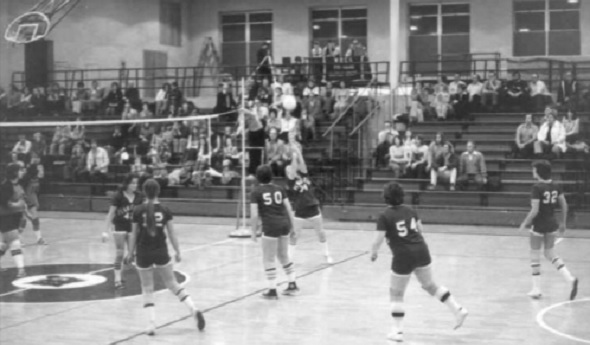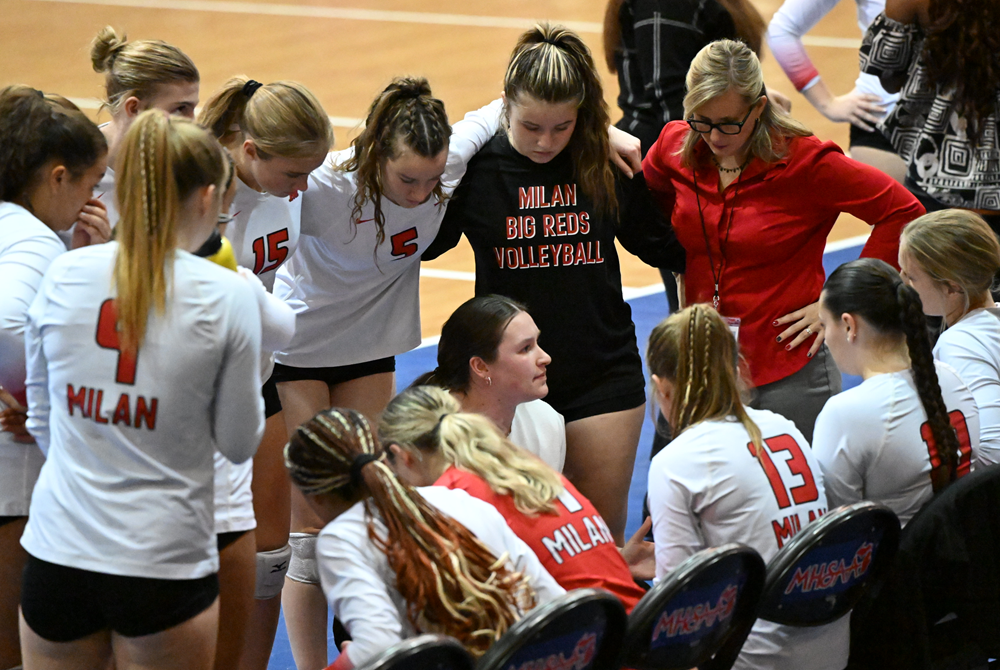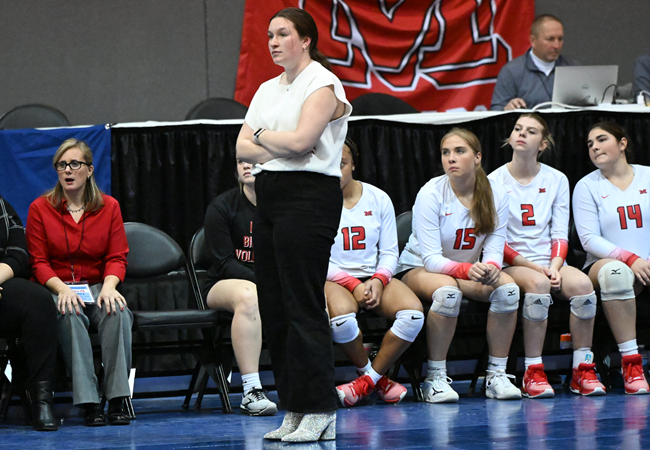
#TBT: MHSAA Hosts 1st Volleyball Finals
September 7, 2017
By Geoff Kimmerly
Second Half editor
Girls volleyball has seen its share of changes over more than four decades as an MHSAA sport – its season moving from winter to fall and the addition to rally scoring in 2005-06 surely would be counted as the most significant.
Along the way, it has become the most popular high school girls sport in the state in terms of participation, with more than 19,000 athletes taking part last season.
The legacy will continue later this season when the MHSAA crowns its 42nd class of champions in the sport. Here’s a look back at the first championship day in 1976, written by MHSAA historian Ron Pesch for a “Finals Flashbacks” published in the 2006 MHSAA Finals program:
The sport of volleyball was invented in 1895 at Springfield College in Holyoke, Massachusetts. Added to the Olympics in 1964, the international amateur athletic event exposed the power game to a broad audience.
In the winter of 1976, the MHSAA added volleyball to the array of championships sponsored by the organization. A total of 458 teams participated in the first volleyball tournament. Broken into three classifications, Class A contests were played on the campus of Schoolcraft College in Livonia, while Class B games were held at Read Field House at Western Michigan University in Kalamazoo. Bay City’s Delta College played host to the Class C-D tournament.
Eight teams qualified for the finals in each classification. Quarterfinal, Semifinal and Final matches were played on the same day, made possible because games were timed during that first year.
Dearborn Fordson had won a non-MHSAA tournament in 1975, and led by tri-captains Lynn March, June Scott and Joan Ferguson, the Tractors earned the MHSAA’s first Class A title by disposing of Grosse Pointe North in the Semifinals, 15-6, 15-4. Fordson then knocked off previously unbeaten Ferndale in the Final, 15-13, 15-5 for the crown.
Parchment carried a nine-player roster, including five seniors, into the first Class B tournament. The Panthers thumped Sturgis, 15-0, 15-8 in the Semifinals, then downed Tecumseh, 15-8, 15-11, to finish the year with a 30-3 record.
Undefeated Flint Holy Rosary, led by coach Jo Lake, rolled to the 1976 Class C-D crown with a 14-5, 13-8 win over Kalamazoo Christian in the Final. The team snagged the Class D title the following year as well, establishing a winning streak of 92 straight matches.
PHOTO: Michigan high school volleyball teams compete during the early days of the sport in this state. (MHSAA file photo.)

After Injury Brings Past Standout Home, Slack Takes Milan on Historic Trip
By
Doug Donnelly
Special for MHSAA.com
November 21, 2023
MILAN – Makenna Slack turned 21 in August, just days before she started her first season as the Milan volleyball coach.
 Little did she know that four months later she would lead the Big Reds to their greatest season in school history.
Little did she know that four months later she would lead the Big Reds to their greatest season in school history.
“I think this season, this run, over the last three weeks, as a Milan player or coach, this was the biggest high I’ve seen from the Milan program,” Slack said. “It was an amazing run and amazing year. It was the best way we could have represented Milan.”
Milan never had won back-to-back District championships before these last two seasons, and never had won a Regional title. Slack’s Big Reds ended up going 29-7-2, finished second in the Huron League behind perennial power Monroe St. Mary Catholic Central, won District and Regional titles and reached the Semifinals at Kellogg Arena.
Milan ended up bowing out with a loss to Grand Rapids West Catholic, ending the season as one of the four remaining teams left in Division 2.
How the Big Reds got there made the postseason run even more remarkable.
Slack played four varsity seasons at Milan after moving to the area in eighth grade. She went on to play volleyball at Olivet College but suffered a devastating knee injury that cut short her career. She had knee reconstruction surgery.
“I basically couldn’t walk or drive for six months,” she said. “The recovery was going to take a year and a half to get back to being an athlete. I decided to cut my losses and moved home.”
Milan varsity volleyball coach Kathy Bradshaw knew Slack was home again and asked if she was interested in coaching. Bradshaw got the idea because she was the junior varsity coach at Milan when Slack was a senior player on the team.
“I was the varsity captain, and I’d come down and help run the practices sometimes,” Slack said. “That’s where I think she saw me as maybe a coach.”
It wasn’t her first coaching opportunity. While in high school she coached club volleyball as a way to earn extra money.
“As a high schooler, I didn’t really realize it, but I took on a little bigger role than most high schoolers do,” she said. “I had my own team, and we went to tournaments and stuff. It started there. It came natural to me. I felt comfortable teaching kids.”
 She was the Milan JV coach for one season, then Bradshaw’s assistant in 2022 when Milan won its first District title since 1999 and reached the Regional Final. Not long after last season, Bradshaw stepped down but encouraged Slack to apply for the head coaching position. Slack wasn’t sure.
She was the Milan JV coach for one season, then Bradshaw’s assistant in 2022 when Milan won its first District title since 1999 and reached the Regional Final. Not long after last season, Bradshaw stepped down but encouraged Slack to apply for the head coaching position. Slack wasn’t sure.
“It seemed like a lot, and I’m so young,” Slack said.
“I ended up applying and got the job. After really thinking about it, I ended up taking it. We have a huge support system in the community. The athletic director is amazing, there is a really good booster group. Feeling the support all around me, I ended up taking the job.”
She had her 21st birthday during the annual MHSAA preseason downtime at the start of August. The following week she was running tryouts for the volleyball team.
Milan had a good season.
“When we were going through league play, we were a solid unit,” she said. “We would win the games we were supposed to win and lose the games we were supposed to lose. It became a little robotic. We weren’t really challenged. No one really challenged us, and we never really challenged anyone.”
Then came the District tournament and a first-round match against Lenawee County Athletic Association champion Adrian Madison. Madison took the first two sets, but Milan rebounded to win three straight and the match. Slack was surprised. She’s still not sure if the Big Reds upset Madison or if Milan was the favorite.
“That was such a huge moment,” she said. “It was very fulfilling. It felt like we were on top. Our postseason run was for sure the highlight of our season. The girls maxed out, their energy was maximum. It was definitely our highlight.”
Milan took another step the following week by winning the Regional, then beat Dearborn Divine Child in the Quarterfinals.
“The girls are an amazing group,” she said. “It’s the best group we’ve had since I’ve been there. The team bonding was strong, the camaraderie was strong. I have a lot of athletes on my team that understand goals and the process you have to do to get to the goal. Having a lot of athletes on board for the full ride made the difference.”
The Big Reds had just three seniors, including their best all-around player in Courtney Nye. They will return Malea Wourman, named the team’s best offensive player, and Lauryn Parris, named the team’s top defensive player.
Slack will graduate from Wayne State University soon and is unsure what her future holds. If she gets a job in the financial field, for example, her coaching career might be over.
“It’s really up in the air right now,” she said. “I don’t know if I’m going to move on with my life or stay in the coaching game. It’s a weird spot to be in.”
Slack loved her time at Milan, both as a player and being part of the coaching staff. If she does have to give it up for now, she can see herself returning to the sidelines someday. If not, she can step aside knowing she helped Milan to its biggest volleyball achievement to date.
“Working with young athletes and being able to guide them is something I truly enjoy,” she said. “I’m thinking at some point I’ll be back into the coaching game.”
 Doug Donnelly has served as a sports and news reporter and city editor over 25 years, writing for the Daily Chief-Union in Upper Sandusky, Ohio from 1992-1995, the Monroe Evening News from 1995-2012 and the Adrian Daily Telegram since 2013. He's also written a book on high school basketball in Monroe County and compiles record books for various schools in southeast Michigan. E-mail him at [email protected] with story ideas for Jackson, Washtenaw, Hillsdale, Lenawee and Monroe counties.
Doug Donnelly has served as a sports and news reporter and city editor over 25 years, writing for the Daily Chief-Union in Upper Sandusky, Ohio from 1992-1995, the Monroe Evening News from 1995-2012 and the Adrian Daily Telegram since 2013. He's also written a book on high school basketball in Monroe County and compiles record books for various schools in southeast Michigan. E-mail him at [email protected] with story ideas for Jackson, Washtenaw, Hillsdale, Lenawee and Monroe counties.
PHOTOS (Top) Milan volleyball coach Makenna Slack, kneeling, huddles with her team during last week's Division 2 Semifinal. (Middle) Slack surveys her team's play during its first trip to Kellogg Arena.

